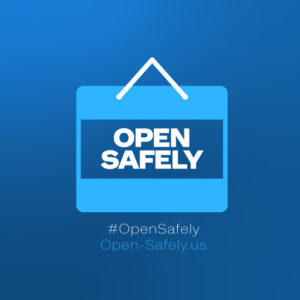This past weekend was the unofficial beginning of summer. After 2+ months of stay at home orders and a few weeks of phased reopening depending on the state you live in, the images of large crowds packed in  close and without masks at a pool in Missouri, on the boardwalk in New Jersey and at a race track in North Carolina were concerning. As I hope many others chose to do, we stayed home and had a family visit on our patio at a social distance.
close and without masks at a pool in Missouri, on the boardwalk in New Jersey and at a race track in North Carolina were concerning. As I hope many others chose to do, we stayed home and had a family visit on our patio at a social distance.
We are hearing stories of super spreaders from Mother’s Day two weeks ago resulting in upticks of COVID-19 cases in many states. We see stories of a hair salon in Missouri where two stylists who were ill exposed over 140 customers. We see stories of no available ICU beds in Montgomery, Alabama where cases have reportedly doubled since that state reopened two weeks ago.
On Friday, the President ordered churches to reopen and threatened to override governors who refused to do so. Fortunately, many faith leaders acted responsibly and outlined plans for continued online or outdoor services until they are certain that they can safely reopen their doors to congregants.
News reports say the virus is still spreading at epidemic levels in 24 states and is not contained. This pandemic is not over. And it may be a long time before it is. So how do we begin to recover and safely reopen?
A new bi-partisan coalition called #OpenSafely launched last week. They published an opinion piece in USA Today on May 20 – Health leaders: We stuck together to #StayHome, now we can start together to #OpenSafely. Their stated common goal: “We are asking decision-makers at all levels to #OpenSafely — to move along the path of opening up our communities again as deliberately as necessary and as quickly as can be safely accomplished”. More information on this initiative and the 20+ leaders behind it can be found here. When I see names like Andy Slavitt, former Acting Administrator, Centers for Medicare and Medicaid Services, and Dr. Leana Wen, former Baltimore City Health Commissioner, on anything during this crisis, I trust their knowledge, expertise, and leadership.
Another health expert that I greatly trust, and respect is Dr. Atul Gawande, chair of Haven’s board of directors and a surgeon at Brigham and Women’s Hospital in Boston and noted author. His advice from a recent piece he wrote for the New Yorker was summarized in a May 21 Becker’s Hospital Review article: The 5 standards to safely lift lockdowns require commitment, not ‘wishful thinking’. As the article said, “Dr. Gawande noted that changing the culture is the toughest part of maintaining standards because it requires people to care about the safety of others as well as themselves, and it is essential as lockdowns are lifted”. He wrote, “There is still much more to learn, such as whether we can safely work at less than six feet apart if everyone has masks on (the way nurses and patients do with one another) and for how long. But answers will come only through commitment to abiding by new norms and measuring results, not through wishful thinking”.
My post last week emphasized the importance of health systems having an effective “digital front door”. As hospitals continue to care for patients with COVID-19 in the coming months, they must be ready to safely care for all patients and convince their communities that they are.
A survey conducted in April by Hackensack Meridian Health looked at what New Jersey patients need to hear from their hospital or doctor to feel safe. It showed that of the 448 respondents, 74% said they need clear information about safety protocols and procedures for patient and staff onsite. 54% of respondents want a contactless option such as virtual care so they can have their appointment from home and 44% want the option to receive care outside the hospital such as in non-hospital buildings and clinics. Their website provides a reassuring message for patients with several one minute videos from clinical leaders and outlines what they are doing to ensure the safety of patients.
A short video from the University of Miami Health is another great example of what health systems need to do to reassure patients that hospitals and clinics are a safe place for care. My former colleague from Brigham and Women’s Hospital, Maureen Fagan, is now Chief Nurse Executive at University of Miami Health and narrates the video that can be found on their website along with additional information on what they are doing to serve patients in the next phase of recovery. Their message is simple: “We are ready to care for you”.
What does all this mean for health IT teams? Well integrated, hardened, and easy to use telehealth solutions continuing at scale. More changes to EHR systems to support new workflows and data collection. Advanced analytics to support enhanced data collection and tracking. And an extended period of work from home for many non-clinical staff and the continued support for connectivity and collaboration tools they have come to depend on over the past two months.
Be well. Be strong. Be smart.
